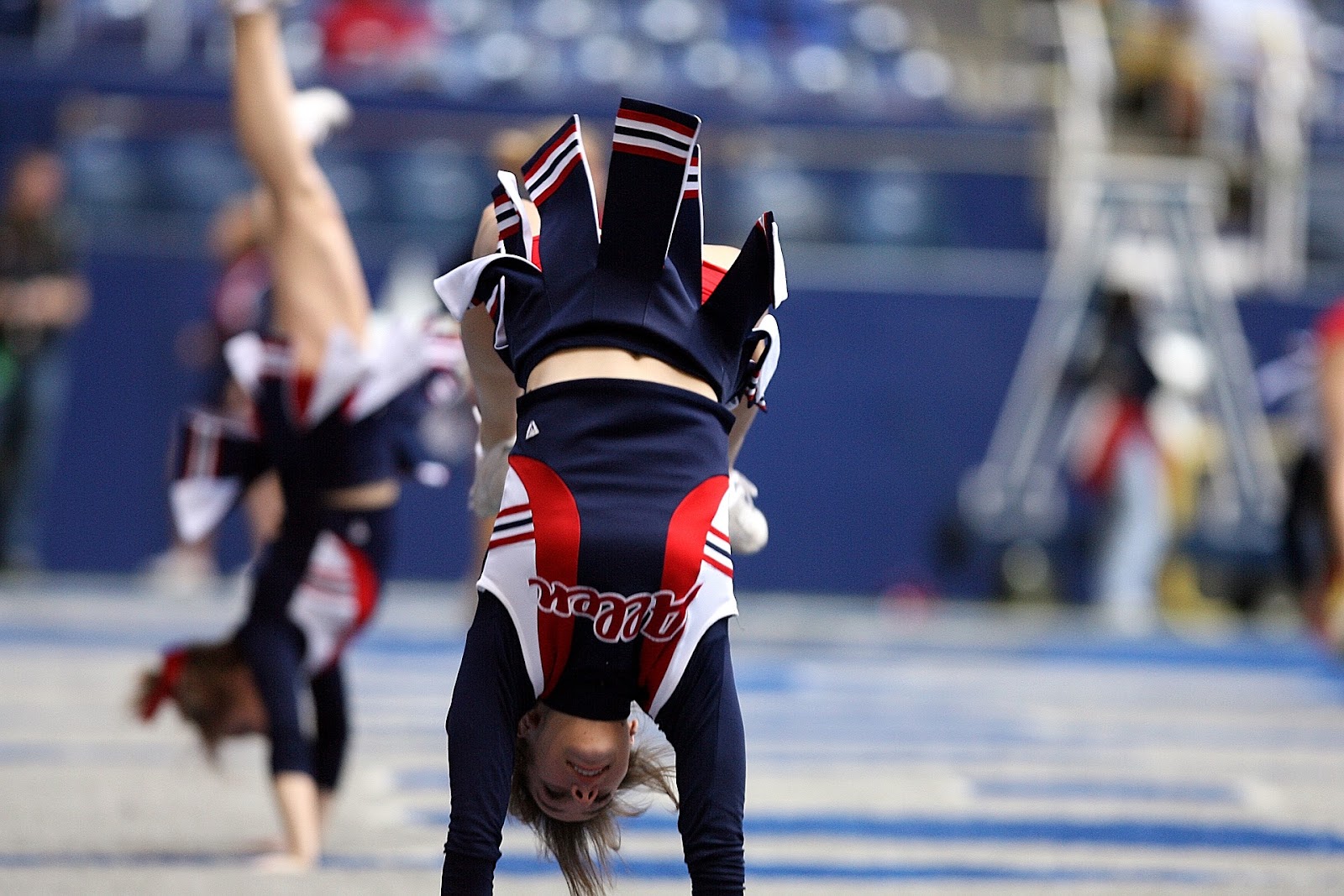For many, the word cheerleading brings forth images of pretty young women waving pom-poms while cheering for the “real” athletes on the field of a high school football game. In reality, cheerleading has become an intense athletic sport, with ties to competitive, choreographed dance and gymnastics.
The history of cheerleading apparel reflects how cheerleading has evolved as a sport. From school sweaters and pom-poms to the aerial acrobatics of competitive cheer, here’s the history of cheerleading apparel.
Now
Let’s start with how present-day cheerleaders present themselves. There are many competitive cheerleaders who will identify that there is a distinct difference between “cheer” and “cheerleading” to those in the know. Competitive cheer is a team sport, in which custom cheer uniforms are a cohesive part of the performance aesthetic. The outfits must find that balance between showmanship and athletic functionality.
Cheerleading is still prevalent in a non-competitive environment. While many cheerleading teams have the more athletic apparel that’s become popular in recent years, more are going for a vintage cheerleader look with the traditional pleated skirts and pom-poms reflecting the team colors. To understand how cheerleading fashion got to where it is today, let’s take a leap back to cheerleading’s humble beginnings.
The Late 1800s
When most people consider male cheerleaders, they think of boys or men who have joined a team to assist with some of the more complex lifts. However, when cheerleading began in the late 1800s, it was an all-male activity.
Cheerleading began when students from the universities would show up in team colors to cheer on their alumni sports teams. Thus, the start of cheerleading fashion dates back to young men in college showing school spirit through colored adornments. These gatherings evolved into practiced, organized cheers, with a few “rah-rahs” and rhymes about success and glory. A few schools started to officially adopt this hype-building strategy and introduced official cheer teams.
The Early to Mid 1900s
Women didn’t start to participate in cheerleading until the early 1920s, and even so, didn’t receive any recognition until the 1940s. At that time, many male collegiates were drafted to the war. As was the case across many different industries, women were left to handle things at home, entering the workforce for the first time and gaining recognition for their efforts.
Cheerleading fashion was in line with the times, with women sporting long skirts that offered ample coverage and bulky sweaters often donning the varsity letter of the school. Somehow during this time, the mindset shifted from cheerleading being a male-dominated activity, to being an activity for all, to being a female dominate activity.
The 1950s-1970s
Around the 1950s, cheerleading became more athletic, with harder training protocols and complex choreography. During this time, cheerleading exploded and was recognized as an organized-- and even professional-- skill. Around this time, teams were starting to be looked at for their sex appeal, with mini skirts replacing the floor length skirts and more skin being revealed. This fashion choice created ample controversy around the sport and those who partook.
In the 1970s, the Dallas Cowboys brought cheerleaders to the Superbowl for the first time and shocked the world with their revealing uniforms and incredible choreography. The Dallas Cowboy cheer team was adorned in shorts rather than skirts, go-go boots, and a tied top, exposing their midriff. This iconic look would shape cheerleading fashion for decades to come.
The 1980s-1990s
By the early 1980s, many professional sports teams had introduced their own cheerleading squads to complement their marketing strategy and reinstate that professional sports is a business.
Competitive cheerleading was introduced at the close of the 1970s and picked up steam during the early 80s. As a result, the stakes were raised, and complex gymnastics combinations were incorporated into the routines. This meant that finding attire that was both fashionable and functional became a priority. Mini-skirts still largely dominated the cheerleading fashion world, but inserts were added for coverage during flips and kicks. Additionally, bare arms became preferred by teams as they developed their athletic skills.
During the 1990s, many of the fashion trends were inspired by cheerleading apparel. Crop tops and short pleated skirts, especially paired with a high ponytail, could be seen at every mall both on mannequins and young fashionistas. It was a look that was adopted across social groups, from the athletes to the artists. 
The 2000s
Perhaps one of the most prolific events for modern cheerleading fashion was the release of Bring it On in the year 2000. This teen rom-com put cheerleading back on the map for those who found themselves amidst the negative attitudes toward the sport that developed over the grunge era of the 1990s. Glitter, too much gel, and metallic shadow all became a staple in the average teenage girl’s wardrobe as a result.
Cheerleading fashion has come full circle over the past century, starting as something casual before evolving into what it is today: a fine balance between fashion and athleticism. As athleisure fashion is prevalent in modern trends, cheerleading fashion still fits in perfectly.

No hay comentarios:
Publicar un comentario
Gracias :)